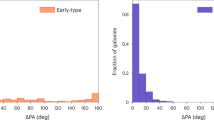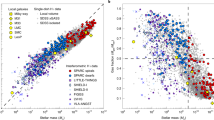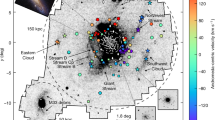Abstract
Frequent accretion of external cold gas is thought to play an important role in galaxy assembly. However, almost all known kinematically misaligned galaxies identify only one gas disk that is misaligned with the stellar disk, implying a single gas acquisition event. Here we report a new configuration in two galaxies where both contain two gas disks misaligned with each other and also with the stellar disk. Such systems are not expected to be stable or long-lasting, challenging the traditional picture of gas accretion of galaxies and their angular momentum build-up. The differences in kinematic position angles are larger than 120° between the two gas disks, and 40° between each gas disk and the stellar component. The star formation activity is enhanced at the interface of the two gas disks compared with the other regions within the same galaxy. Such systems illustrate that low-redshift galaxies can still experience multiple gas acquisition events, and provide a new view into the origins of galactic gas.
This is a preview of subscription content, access via your institution
Access options
Access Nature and 54 other Nature Portfolio journals
Get Nature+, our best-value online-access subscription
$29.99 / 30 days
cancel any time
Subscribe to this journal
Receive 12 digital issues and online access to articles
$119.00 per year
only $9.92 per issue
Buy this article
- Purchase on Springer Link
- Instant access to full article PDF
Prices may be subject to local taxes which are calculated during checkout






Similar content being viewed by others
Data availability
The MPL-11 data (including all the MPL-10 data) that support the findings of this paper are available through SDSS Data Release 17 that can be downloaded from https://www.sdss.org/dr17/manga/. The multi-waveband images from DESI Legacy Surveys can be downloaded from https://www.legacysurvey.org/.
References
Rubin, V. C. Kinematics of NGC 4826: a sleeping beauty galaxy, not an evil eye. Astron. J. 107, 173 (1994).
Schweizer, F. & Seitzer, P. Ages and metallicities of young globular clusters in the merger remnant NGC 7252. Astron. J. 116, 2206–2219 (1998).
Bettoni, D. On the observed state of the stellar rotation curve in bars. Astron. J. 97, 79 (1989).
Bertola, F. & Bettoni, D. The counterrotation of gas and stars in the dust lane elliptical NGC 5898. Astrophys. J. 329, 102 (1988).
Bertola, F., Buson, L. M. & Zeilinger, W. W. Counter-rotation in dust-lane ellipticals and the implications for accretion events in galaxies. Nature 335, 705–706 (1988).
Kuijken, K., Fisher, D. & Merrifield, M. R. A search for counter-rotating stars in S0 galaxies. Mon. Not. R. Astron. Soc. 283, 543–550 (1996).
Kannappan, S. J. & Fabricant, D. G. A broad search for counterrotating gas and stars: evidence for mergers and accretion. Astron. J. 121, 140–147 (2001).
Pizzella, A., Corsini, E. M., Vega Beltrán, J. C. & Bertola, F. Ionized gas and stellar kinematics of seventeen nearby spiral galaxies. Astron. Astrophys. 424, 447–454 (2004).
Davis, T. A. et al. The ATLAS3D project - X. On the origin of the molecular and ionized gas in early-type galaxies. Mon. Not. R. Astron. Soc. 417, 882–899 (2011).
Chen, Y.-M. et al. The growth of the central region by acquisition of counterrotating gas in star-forming galaxies. Nat. Commun. 7, 13269 (2016).
Jin, Y.-F. et al. SDSS-IV MaNGA: properties of galaxies with kinematically decoupled stellar and gaseous components. Mon. Not. R. Astron. Soc. 463, 913–926 (2016).
Martinsson, T. P. K. et al. MUSE observations of the counter-rotating nuclear ring in NGC 7742. Astron. Astrophys. 612, A66 (2018).
Bryant, J. J. et al. The SAMI Galaxy Survey: stellar and gas misalignments and the origin of gas in nearby galaxies. Mon. Not. R. Astron. Soc. 483, 458–479 (2019).
Bevacqua, D., Cappellari, M. & Pellegrini, S. SDSS-IV MaNGA: integral-field kinematics and stellar population of a sample of galaxies with counter-rotating stellar discs selected from about 4000 galaxies. Mon. Not. R. Astron. Soc. 511, 139–157 (2022).
Bao, M. et al. Different formation scenarios of counter-rotating stellar disks in nearby galaxies. Astrophys. J. Lett. 926, L13 (2022).
Bundy, K. et al. Overview of the SDSS-IV MaNGA Survey: Mapping nearby Galaxies at Apache Point Observatory. Astrophys. J. 798, 7 (2015).
Drory, N. et al. The MaNGA Integral Field Unit Fiber Feed System for the Sloan 2.5 m Telescope. Astron. J. 149, 77 (2015).
Wake, D. A. et al. The SDSS-IV MaNGA sample: design, optimization, and usage considerations. Astron. J. 154, 86 (2017).
Braun, R., Walterbos, R. A. M., Kennicutt, R. C., Jr. & Tacconi, L. J. Counterrotating gaseous disks in NGC 4826. Astrophys. J. 420, 558 (1994).
Fisher, D., Illingworth, G. & Franx, M. The dynamics and structure of the S0 galaxy NGC 7332. Astron. J. 107, 160 (1994).
Plana, H. & Boulesteix, J. Extended ionized gas in elliptical galaxies. I. Multicomponents in NGC 1052 and NGC 7332. Astron. Astrophys. 307, 391–402 (1996).
Hunter, D. A., van Woerden, H. & Gallagher, J. S. Neutral hydrogen and star formation in the irregular galaxy NGC 4449. Astron. J. 118, 2184–2210 (1999).
Corsini, E. M., Pizzella, A. & Bertola, F. The orthogonal gaseous kinematical decoupling in the Sa spiral NGC 2855. Astron. Astrophys. 382, 488–494 (2002).
Roy, J.-R. & Kunth, D. Dispersal and mixing of oxygen in the interstellar medium of gas-rich galaxies. Astron. Astrophys. 294, 432–442 (1995).
de Avillez, M. A. & Mac Low, M.-M. Mixing timescales in a Supernova-driven Interstellar Medium. Astrophys. J. 581, 1047–1060 (2002).
Krajnović, D., Cappellari, M., de Zeeuw, P. T. & Copin, Y. Kinemetry: a generalization of photometry to the higher moments of the line-of-sight velocity distribution. Mon. Not. R. Astron. Soc. 366, 787–802 (2006).
Salim, S. et al. GALEX-SDSS-WISE Legacy Catalog (GSWLC): star formation rates, stellar masses, and dust attenuations of 700,000 low-redshift galaxies. Astrophys. J. Suppl. Ser. 227, 2 (2016).
Chang, Y.-Y., van der Wel, A., da Cunha, E. & Rix, H.-W. Stellar masses and star formation rates for 1M galaxies from SDSS+WISE. Astrophys. J. Suppl. Ser. 219, 8 (2015).
Baldwin, A., Phillips, M. M. & Terlevich, R. Classification parameters for the emission-line spectra of extragalactic objects. Publ. Astron. Soc. Pac. 93, 5–19 (1981).
Dey, A. et al. Overview of the DESI legacy imaging surveys. Astron. J. 157, 168 (2019).
Kewley, L. J. et al. Theoretical modeling of starburst galaxies. Astrophys. J. 556, 121–140 (2001).
Kauffmann, G. et al. The host galaxies of active galactic nuclei. Mon. Not. R. Astron. Soc. 346, 1055–1077 (2003).
Li, S.-L. et al. The impact of merging on the origin of kinematically misaligned and counter-rotating galaxies in MaNGA. Mon. Not. R. Astron. Soc. 501, 14–23 (2021).
Sánchez Almeida, J., Elmegreen, B. G., Muñoz-Tuñón, C. & Elmegreen, D. M. Star formation sustained by gas accretion. Astron. Astrophys. Rev. 22, 71 (2014).
Wang, S. et al. From large-scale environment to CGM angular momentum to star-forming activities - I. Star-forming galaxies. Mon. Not. R. Astron. Soc. 509, 3148–3162 (2022).
Hwang, H. C. et al. Anomalously low-metallicity regions in MaNGA star-forming galaxies: accretion caught in action? Astrophys. J. 872, 144 (2019).
Sánchez Almeida, J. et al. Metallicity inhomogeneities in local star-forming galaxies as a sign of recent metal-poor gas accretion. Astrophys. J. 783, 45 (2014).
Kewley, L. J. & Dopita, M. A. Using strong lines to estimate abundances in extragalactic H II regions and starburst galaxies. Astrophys. J. Suppl. Ser. 142, 35–52 (2002).
Smirnova-Pinchukova, I. et al. The Close AGN Reference Survey (CARS). No obvious signature of AGN feedback on star formation, but subtle trends. Astron. Astrophys. 659, A125 (2022).
Dalcanton, J. The metallicity of galaxy disks: infall versus outflow. Astrophys. J. 658, 941–959 (2007).
Khoperskov, S. et al. Extreme kinematic misalignment in IllustrisTNG galaxies: the origin, structure, and internal dynamics of galaxies with a large-scale counterrotation. Mon. Not. R. Astron. Soc. 500, 3870–3888 (2021).
Battaglia, G., Fraternali, F., Oosterloo, T. & Sancisi, R. HI study of the warped spiral galaxy NGC5055: a disk/dark matter halo offset? Astron. Astrophys. 447, 49–62 (2006).
Józsa, G. I. G. Kinematic modelling of disk galaxies. II. A case-study of symmetrically warped galaxy disks. Astron. Astrophys. 468, 903–917 (2007).
Schmidt, P. et al. Structure and kinematics of the nearby dwarf galaxy UGCA 105. Astron. Astrophys. 561, A28 (2014).
Shetty, R., Vogel, S. N., Ostriker, E. C. & Teuben, P. J. Kinematics of spiral-arm streaming in M51. Astrophys. J. 665, 1138–1158 (2007).
Smee, S. A. et al. The multi-object, fiber-fed spectrographs for the Sloan Digital Sky Survey and the Baryon Oscillation Spectroscopic Survey. Astron. J. 146, 32 (2013).
Gunn, J. E. et al. The 2.5 m telescope of the Sloan Digital Sky Survey. Astron. J. 131, 2332–2359 (2006).
Blanton, M. R. et al. Sloan Digital Sky Survey IV: mapping the Milky Way, nearby galaxies, and the distant universe. Astron. J. 154, 28 (2017).
Westfall, K. B. et al. The data analysis pipeline for the SDSS-IV MaNGA IFU Galaxy Survey: overview. Astron. J. 158, 231 (2019).
Cappellari, M. & Emsellem, E. Parametric recovery of line-of-sight velocity distributions from absorption-line spectra of galaxies via penalized likelihood. Publ. Astron. Soc. Pac. 116, 138–147 (2004).
Yan, R. B. et al. SDSS-IV MaStar: a large and comprehensive empirical stellar spectral library—first release. Astrophys. J. 883, 175 (2019).
Noll, S. et al. Analysis of galaxy spectral energy distributions from far-UV to far-IR with CIGALE: studying a SINGS test sample. Astron. Astrophys. 507, 1793–1813 (2009).
Bertola, F. et al. Testing the gravitational field in elliptical galaxies: NGC 5077. Astrophys. J. 373, 369 (1991).
Acknowledgements
We thank D. Xu, S. Feng, T. Wang and M. Xiao for helpful discussion and comments. Y.M.C. acknowledges support from the National Key Research and Development Programme of China (grant No. 2017YFA0402700), the National Natural Science Foundation of China (grant Nos. 11922302, 11733002 and 12121003) and the China Manned Space Project (grant No. CMS-CSST-2021-A05). A.M. acknowledges support from the Special Astrophysical Observatory of the Russian Academy of Sciences government contract approved by the Ministry of Science and Higher Education of the Russian Federation. D.B. acknowledges partial support from the Russian Science Foundation (grant No. 22-12-00080). J.G.F-T. acknowledges support from Proyecto Fondecyt Iniciación (grant No. 11220340), ANID Concurso de Fomento a la Vinculación Internacional para Instituciones de Investigación Regionales Proyecto (grant No. FOVI210020) and the Joint Committee ESO-Government of Chile 2021 (grant No. ORP 023/2021). R.R. acknowledges support from Conselho Nacional de Desenvolvimento Científico e Tecnológico (CNPq, Proj. 311223/2020-6, 304927/2017-1 and 400352/2016-8), Fundação de amparo à pesquisa do Rio Grande do Sul (FAPERGS, Proj. 16/2551-0000251-7 and 19/1750-2) and Coordenação de Aperfeiçoamento de Pessoal de Nível Superior (CAPES, Proj. 0001). Funding for the Sloan Digital Sky Survey IV has been provided by the Alfred P. Sloan Foundation, the US Department of Energy Office of Science and the participating institutions. SDSS-IV acknowledges support and resources from the Centre for High Performance Computing at the University of Utah. The SDSS website is www.sdss.org. SDSS-IV is managed by the Astrophysical Research Consortium for the Participating Institutions of the SDSS Collaboration including the Brazilian Participation Group, the Carnegie Institution for Science, Carnegie Mellon University, Center for Astrophysics ∣ Harvard & Smithsonian, the Chilean Participation Group, the French Participation Group, Instituto de Astrofísica de Canarias, The Johns Hopkins University, Kavli Institute for the Physics and Mathematics of the Universe/University of Tokyo, the Korean Participation Group, Lawrence Berkeley National Laboratory, Leibniz Institut für Astrophysik Potsdam, Max-Planck-Institut für Astronomie (Heidelberg), Max-Planck-Institut für Astrophysik (Garching), Max-Planck-Institut für Extraterrestrische Physik, National Astronomical Observatories of China, New Mexico State University, New York University, University of Notre Dame, Observatário Nacional/MCTI, The Ohio State University, Pennsylvania State University, Shanghai Astronomical Observatory, United Kingdom Participation Group, Universidad Nacional Autónoma de México, University of Arizona, University of Colorado Boulder, University of Oxford, University of Portsmouth, University of Utah, University of Virginia, University of Washington, University of Wisconsin, Vanderbilt University and Yale University.
Author information
Authors and Affiliations
Contributions
X.C. made the plots and led the writing of the very preliminary version of the draft manuscript. Y.-M.C. discovered these two galaxies and conceived the project. Y.-M.C. and Y.S. suggested the physical pictures discussed in this paper and edited the manuscript. M.B. helped in fitting the disk models. A.M., D.B., S.-L.L., J.G.F.-T., R.A.R., R.R. and R.R.L. were involved in the comments in the manuscript and the interpretation of the results.
Corresponding author
Ethics declarations
Competing interests
The authors declare no competing interests.
Peer review
Peer review information
Nature Astronomy thanks Glenn Kacprzak and the other, anonymous, reviewer(s) for their contribution to the peer review of this work.
Additional information
Publisher’s note Springer Nature remains neutral with regard to jurisdictional claims in published maps and institutional affiliations.
Rights and permissions
Springer Nature or its licensor holds exclusive rights to this article under a publishing agreement with the author(s) or other rightsholder(s); author self-archiving of the accepted manuscript version of this article is solely governed by the terms of such publishing agreement and applicable law.
About this article
Cite this article
Cao, X., Chen, YM., Shi, Y. et al. Multiple gas acquisition events in galaxies with dual misaligned gas disks. Nat Astron 6, 1464–1472 (2022). https://doi.org/10.1038/s41550-022-01788-8
Received:
Accepted:
Published:
Issue Date:
DOI: https://doi.org/10.1038/s41550-022-01788-8



